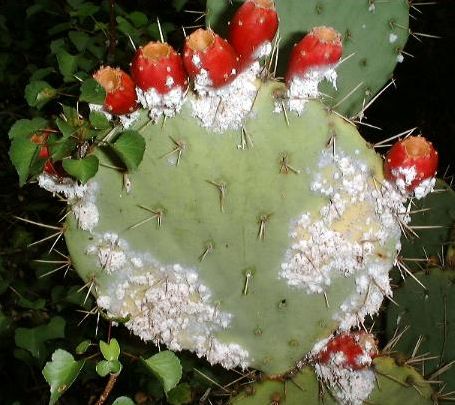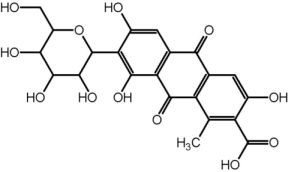|
|||||
|
|||||||
|
    An initiative of :Stichting Food-Info
|
| Food-Info.net> Topics > Food components > Food colours > Natural food colours > Cochineal Cochineal, Carmine, Carminic acid (E120)Carmine is the name of the colour pigment obtained from the insect Dactylopius coccus (old name Coccus cacti), that lives on cacti from the genus Opuntia. The insect is native to tropical South and Central America and produces the pigment as a deterrent against other insects. The pigment can be obtained from the body and eggs of the insect. It is still used as an organic ant-repellent.  Cochineal insects on an Opuntia cactus (Source) Carmine is the name of the pigment; the actual colour is carminic acid (C22H20O13):  Structure 1 : Carmine Cochineal is one of the few natural and water-soluble colorants that resist degradation with time. It is the most light- and heat-stable and oxidation-resistant of all the natural colorants and is even more stable than some synthetic food colours. Cochineal it is neither toxic nor known to be carcinogenic. However, the dye can induce an anaphylactic-shock reaction in a small number of people, due to impurities in the preparation, not due to the carminic acid. History Cochineal was already used as a colour by the Aztec and Maya peoples of Central and North America . Cochineal was a commodity of much value, even comparable to gold. Cities send bags of cochineal to the capital Tenochtitlán as a yearly contribute to the emperor. The Spanish conquerors of Central America saw the value of the dye, which produced a much better colour than the dyes used in Europe at the time. The dye, which at the time was mainly used in cosmetics and textiles and to a lesser extend in foods, became very popular in Europe. Roman Catholic Cardinals robes were coloured with cochineal, as were the jackets of the British military. Cochineal was a highly prized product and was regularly traded on the London and Amsterdam Commodity Exchanges. As its origins were not known to most Europeans, the American colonists bought their cochineal from Europe, instead directly from Mexico ... In the 19th century the insects were imported and grown on a large scale on the Canary Islands and the Mexican monopoly came to an end. In 1868, the Canary Islands exported six million pounds of cochineal, equivalent to 420.000.000.000 insects.... In addition as a dye for textiles, cochineal became widely used as a food colouring. Cakes, cookies, beverages, jam, jelly, ice cream, sausages, pies, dried fish, yogurt, cider, maraschino cherries and tomato products were brightened with it as were chewing gum, pills and cough drops. Cosmetic rouge was developed with cochineal as the main ingredient. Cochineal is still widely used in cosmetics. The demand for cochineal fell sharply with the appearance on the market of alizarin crimson and many other artificial (food and textile) dyes discovered in Europe in the middle of the 19th century. Trade in cochineal almost totally disappeared in the course of the 20th century, but in recent years it has become commercially valuable again as many producers (and consumers) prefer natural colours over synthetic colours. However, most consumers are unaware that the ‘natural colouring E120' refers to a dye that is derived from an insect. It is thus not suitable for vegetarians and is banned by some religions. Production The insects are killed by immersion in hot water (after which they are dried) or by exposure to sunlight, steam, or the heat of an oven. Each method produces a different colour which results in the varied appearance of commercial cochineal. The insects must be dried to about 30 percent of their original body weight before they can be stored without decaying. It takes about 155,000 insects to make one kilogram of cochineal. There are two principal forms of cochineal dye: cochineal extract (E120(ii) ) is a colouring made from the raw dried and pulverised bodies of insects with around 20% carminic acid; and carmine ( E120(i) ) a more purified colouring made from cochineal. Polish cochineal Polish cochineal is another dye, which was widely used until the mid 19th century as a textile dye. It was not used as a food dye. Polish cochineal is also derived from an insect, the Margarodes polonicus, found in Eastern Europe and parts of Asia. Cochineal Red This is the name of an azo dye, E124, which bears no resemblance with cochineal, but produces a similar colour, hence the (confusing) name. Sources:
|
|
| ||
| Food-Info.net is an initiative of Stichting Food-Info, The Netherlands | ||||||